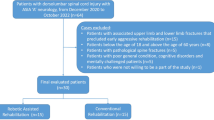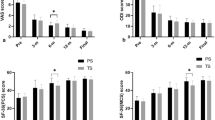Abstract
Study design:
Cross-sectional study.
Objective:
To study the manifestation of spasticity in daily life of the patients with spinal cord injury, their perception of spasticity and spasticity-related discomfort.
Setting:
Rehabilitation center in the Netherlands.
Methods:
Twenty-six patients with motor complete spinal cord injury (SCI) and spasticity in the lower limbs completed a questionnaire. The following outcome measures were used: manifestation of spasticity, activities during which spasticity occurs, perceived degree of spasticity and resulting discomfort, measured with visual analog scale (VAS) and Borg scale, respectively.
Results:
In general, spasticity manifested as extensor spasms (84.6%), flexor spasms and/or clonus (both 69.2%), and less often as continuous tension (57.7%). The registered activities were categorized into five main groups: ‘changing position’ was the largest group (22.0%) with a median VAS of 6.8 (range: 2.5–9.5) and median Borg scale of 3.0 (range: 1.0–7.0). Other groups of activities were ‘making a transfer’ (20.7%), ‘activities of daily living’ (17.1%), ‘being active’ (17.1%) and ‘stable body position’ (12.2%). The overall correlation between VAS and Borg was moderate (Spearman's rho=0.53, P=0.005).
Conclusions:
Patients with complete SCI experienced several manifestations of spasticity, extensor spasms being the most common. Many daily life activities elicited different manifestations of spasticity. The experienced discomfort was only moderately related to the perceived degree of spasticity during an activity. Possibly, the discomfort is influenced by other factors than the perceived spasticity alone.
Similar content being viewed by others
Log in or create a free account to read this content
Gain free access to this article, as well as selected content from this journal and more on nature.com
or
References
Lance JW . Symposium synopsis. In: Feldman RG, Young RR, Koella WP (eds). Spasticity: Disordered Motor Control. Chicago: Year Book 1980, pp 485–494.
Priebe MM, Sherwood AM, Thornby JI, Kharas NF, Markowski J . Clinical assessment of spasticity in spinal cord injury: a multidimensional problem. Arch Phys Med Rehabil 1996; 77: 713–716.
Sköld C, Levi R, Seiger A . Spasticity after traumatic spinal cord injury: nature, severity, and location. Arch Phys Med Rehabil 1999; 80: 1548–1557.
Adams MM, Hicks AL . Spasticity after spinal cord injury. Spinal Cord 2005; 43: 577–586.
Pandyan AD, Gregoric M, Barnes MP, Wood D, Van Wijck F, Burridge J et al. Spasticity: clinical perceptions, neurological realities and meaningful measurement. Disabil Rehabil 2005; 27: 2–6.
Levi R, Hultling C, Nash MS, Seiger A . The Stockholm spinal cord injury study: 1. Medical problems in a regional SCI population. Paraplegia 1995; 33: 308–315.
Johnson RL, Gerhart KA, McCray J, Menconi JC, Whiteneck GG . Secondary conditions following spinal cord injury in a population-based sample. Spinal Cord 1998; 36: 45–50.
Mahoney JS, Engebretson JC, Cook KF, Hart KA, Robinson-Whelen S, Sherwood AM . Spasticity experience domains in persons with spinal cord injury. Arch Phys Med Rehabil 2007; 88: 287–294.
Adams MM, Ginis KA, Hicks AL . The spinal cord injury spasticity evaluation tool: development and evaluation. Arch Phys Med Rehabil 2007; 88: 1185–1192.
Geneva World Health Organization. WHO: International Classification of Functioning, Disability and Health (ICF). World Health Organization: Geneva, 2001, Chapter 5.1, pp 18-19.
Sköld C . Spasticity in spinal cord injury: self- and clinically rated intrinsic fluctuations and intervention-induced changes. Arch Phys Med Rehabil 2000; 81: 144–149.
Platz T, Eickhof C, Nuyens G, Vuadens P . Clinical scales for the assessment of spasticity, associated phenomena, and function: a systematic review of the literature. Disabil Rehabil 2005; 27: 7–18.
Lechner HE, Frotzler A, Eser P . Relationship between self- and clinically rated spasticity in spinal cord injury. Arch Phys Med Rehabil 2006; 87: 15–19.
Maynard Jr FM, Bracken MB, Creasey G, Ditunno Jr JF, Donovan WH, Ducker TB et al. International Standards for Neurological and Functional Classification of Spinal Cord Injury. American Spinal Injury Association. Spinal Cord 1997; 35: 266–274.
Borg G . Psychophysical scaling with applications in physical work and the perception of exertion. Scand J Work Environ Health 1990; 16 (Suppl 1): 55–58.
Dawes HN, Barker KL, Cockburn J, Roach N, Scott O, Wade D . Borg's rating of perceived exertion scales: do the verbal anchors mean the same for different clinical groups? Arch Phys Med Rehabil 2005; 86: 912–916.
Little JW, Micklesen P, Umlauf R, Britell C . Lower extremity manifestations of spasticity in chronic spinal cord injury. Am J Phys Med Rehabil 1989; 68: 32–36.
Wu M, Hornby TG, Hilb J, Schmit BD . Extensor spasms triggered by imposed knee extension in chronic human spinal cord injury. Exp Brain Res 2005; 162: 239–249.
Schmit BD, McKenna-Cole A, Rymer WZ . Flexor reflexes in chronic spinal cord injury triggered by imposed ankle rotation. Muscle Nerve 2000; 23: 793–803.
Wu M, Hornby TG, Kahn JH, Schmit BD . Flexor reflex responses triggered by imposed knee extension in chronic human spinal cord injury. Exp Brain Res 2006; 168: 566–576.
Author information
Authors and Affiliations
Corresponding author
Rights and permissions
About this article
Cite this article
Fleuren, J., Voerman, G., Snoek, G. et al. Perception of lower limb spasticity in patients with spinal cord injury. Spinal Cord 47, 396–400 (2009). https://doi.org/10.1038/sc.2008.153
Received:
Revised:
Accepted:
Published:
Issue date:
DOI: https://doi.org/10.1038/sc.2008.153
Keywords
This article is cited by
-
Limb accelerations during sleep are related to measures of strength, sensation, and spasticity among individuals with spinal cord injury
Journal of NeuroEngineering and Rehabilitation (2022)
-
The experience of spasticity after spinal cord injury: perceived characteristics and impact on daily life
Spinal Cord (2018)
-
Treatment patterns of in-patient spasticity medication use after traumatic spinal cord injury: a prospective cohort study
Spinal Cord (2018)
-
Neuropathic Pain After Spinal Cord Injury: Challenges and Research Perspectives
Neurotherapeutics (2018)
-
Reliability of the Modified Ashworth Scale and Modified Tardieu Scale in patients with spinal cord injuries
Spinal Cord (2017)



